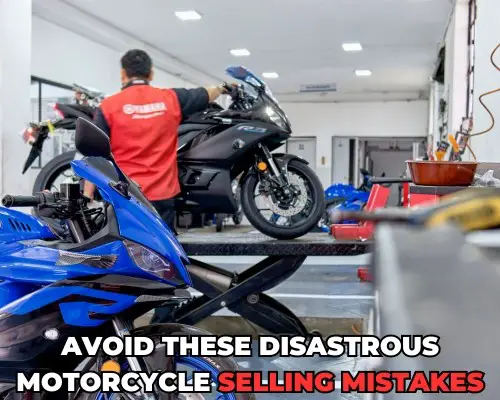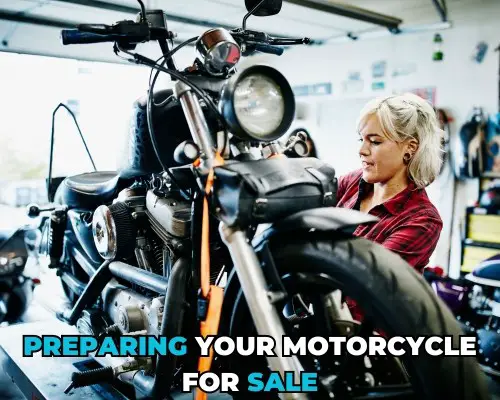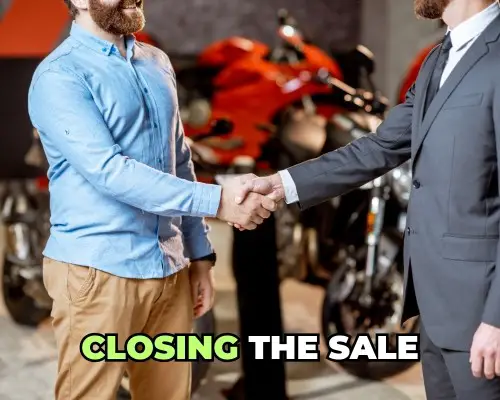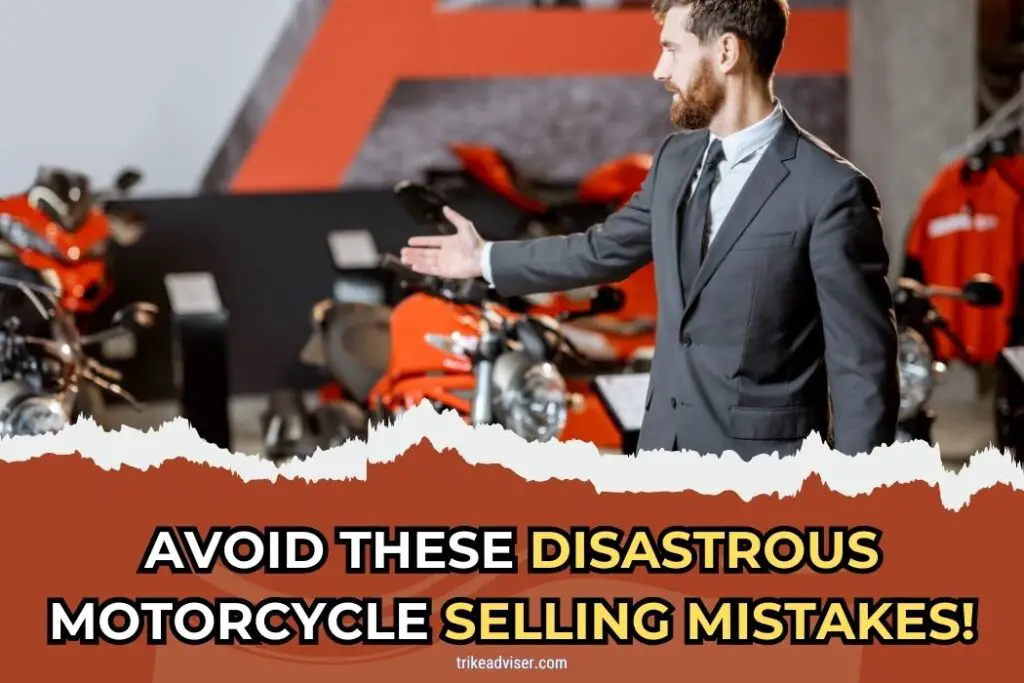Selling your beloved bike should feel straightforward, right? Yet, so many bike sales end disastrously. Why? Small oversights can lead to big regrets.
Maybe it’s setting the wrong price, or maybe it’s mishandling the buyer’s first impression. These mistakes aren’t just common—they’re costly.
Think selling a bike is just about listing it somewhere? Think again. It’s a nuanced art. You need to know what potential buyers avoid like a rainstorm during a ride.
Are you underselling features? Are your photos less than stellar? Did you remember to handle all the paperwork properly?
Avoiding these pitfalls isn’t hard, but knowing them is crucial. Let’s dive into the essentials of motorcycle selling done right—no buyer’s remorse here, just solid deals sealed with confidence.
Avoid These 10 Motorcycle Selling Mistakes to Sell Faster!

Set a Realistic Asking Price
Is your price too high or too low? A big mistake. Research the market deeply. Use resources like Kelley Blue Book to nail that fair price.
Condition and features should guide you. A fair price attracts serious buyers, just like the right bait catches more fish. Remember, a well-priced motorcycle can sell up to 50% faster than those priced on a whim.
Prepare Your Motorcycle
Ever noticed how a polished bike at a show catches your eye? That’s your goal. Clean your bike meticulously, focusing on overlooked spots like under the seat or the chain.
Make minor repairs—those little tweaks improve performance and aesthetics significantly. Think of it as grooming your bike for its big day; a well-groomed bike can increase its value by up to 20%.
Take High-Quality Photos
First impressions are digital now. Capture your motorcycle from multiple angles using high-quality settings on your camera.
Natural lighting works best to highlight your bike’s true color and condition. Avoid cluttered backgrounds—they steal the focus from your bike. Great photos can increase click-through rates on listings by over 30%.
Provide Accurate Information
Honesty builds trust. Fully disclose your motorcycle’s condition, mileage, and history. This transparency helps avoid disputes and paves the way for smoother transactions.
Accurate descriptions can reduce the time your motorcycle spends on the market by helping buyers make quicker decisions.
Choose the Right Selling Platform
Just as crucial as the product you’re selling is where you decide to market it. Think about things like audience reach and costs.
Local online classifieds may draw in nearby purchasers more rapidly, but online sites such as eBay Motors usually reach wider audiences. Make a decision based on the kind of buyer you want to attract.
Negotiate Effectively
Negotiations go more smoothly if you know in advance what your lowest acceptable price is. Instead, then letting lowball offers get in the way of your conversation, focus on the special qualities of your bike. You can get a sale for 10% less than you asked for if you know how to negotiate.
Protect Yourself
In today’s digital age, scams are rife. Ensure all paperwork is verifiable and complete before finalizing the sale.
Use secure payment methods like escrow services for high-value transactions to avoid fraudulent schemes. Proper documentation can prevent legal headaches down the line.
Consider Selling to a Dealer
Not keen on handling countless inquiries? A dealer might be your best bet. While you might not get the top dollar you would from a private sale, the convenience and security of a dealer sale are often worth the trade-off, especially if you need to sell quickly.
Time Your Sale Wisely
Timing is everything. Selling in spring? That’s when buyers are gearing up for riding season. Studies show that motorcycles listed in early spring can sell up to 15% faster and at higher prices than those listed at other times of the year.
Keep a keen eye on market trends and economic indicators that influence buyer behavior.
Leverage a Cash Offer
Need to sell urgently? A cash offer might be your solution. It cuts through the usual sales hassle and speeds up the process significantly.
Ensure the buyer is reputable—companies like Powersport Buyers are known for fair deals and swift transactions.
A cash sale eliminates the worry of payment defaults, which are more common than you might think.
Preparing Your Motorcycle for Sale

It’s important to give prospective buyers confidence while preparing your motorcycle for sale, in addition to making it look excellent. Here’s how to demonstrate to them that your bike is well-loved and maintained.
Detailed Cleaning Tips
Pre-Wash: Start with a pre-wash to loosen dirt and debris. Think of it like prepping a canvas for a masterpiece. This step prevents fine scratches during the deeper cleaning stages.
Wheels and Spokes: These parts often hold the most stubborn grime. Use a dedicated wheel brush and mild cleaner to bring back the shine, demonstrating meticulous care to your buyers.
Controls and Dashboard: Clean these areas with a gentle, electronics-safe cleaner. Remember, the details matter. Shiny controls and a spotless dashboard make a strong impression.
Engine Cleaning: A pristine engine not only looks great but speaks volumes about your maintenance regime. Before starting, make sure the engine is cool, and use degreasers sparingly to prevent damage.
Rinse and Dry: To prevent damaging the paint, thoroughly rinse with low-pressure water. To avoid water stains, carefully dry with microfiber towels thereafter. These small details may make your bike stand out in both real life and pictures.
Polish and Wax: To protect the paint, use a high-quality wax and polish chrome and metal surfaces. This improves the bike’s aesthetics and demonstrates your commitment to maintaining it.
Leather Care: Use a high-quality protectant on leather accessories and seats. This not only revives the material but also sends a message about how you cherish every part of your motorcycle.
Essential Repairs Before Listing
Address Mechanical Issues: Fixing brakes, suspension, and electrical systems is crucial. These are the first things savvy buyers check. Imagine a buyer’s peace of mind when everything works as expected.
Inspect Tires: Ensure they are not just inflated but also free from serious wear. Good tires suggest a safe, ride-ready bike.
Replace Worn Parts: Fresh brake pads or a new chain can make a significant difference. Such proactive replacements can justify a higher asking price because they reduce the buyer’s future maintenance concerns.
Exhaust System Check: A quiet, smooth-running exhaust system reassures buyers about environmental and noise regulations.
Upgrades That Increase Motorcycle Value
Performance Upgrades: Things like a tuned engine or an enhanced air intake system can turn heads. More importantly, they can turn the ride into something exhilarating—just what a new owner might be craving.
Safety First: Upgrades like superior brakes or LED lighting are not just selling points; they are genuine enhancements to the bike’s operational safety and aesthetics.
Custom Touches: Personalization, such as a custom paint job or unique seat, can significantly increase appeal.
Make sure these are tasteful—what appeals to you should ideally appeal to a broader audience to maximize resale value.
Smart Investments: Not all upgrades add value in the eyes of every buyer. It’s important to invest in changes that have widespread appeal, such as ergonomic improvements or universally respected brands for aftermarket parts.
Sell Your Motorcycle – Get Top Dollar When Selling

It takes more than just scrubbing your motorcycle down and attaching a price tag to get the greatest deal.
It’s about positioning your bike strategically to attract the best bidder, knowing the ins and outs of the market and its attraction.
Research Market Conditions
- Local Demand Insight: Dive into the local market dynamics. How quickly are bikes selling in your area? What’s the going rate for a model like yours? Local motorcycle clubs and online forums can offer real-time feedback and insights that generic guides can’t.
- Seasonal Trends: Yes, motorcycles tend to sell better in warmer months, but did you know that listing your bike right before spring hits can get you ahead of the market curve? This timing can translate into higher offers as buyers get ready for riding season.
Check Book Values
- Utilize Pricing Guides: Resources like Kelley Blue Book or NADA Guides are starting points, but remember they offer averages that might not account for local spikes in demand or scarcity.
- Manufacturer Websites: These can be goldmines for recent models, providing a baseline for comparison but always adjusting for local market conditions.
Consider Modifications
- Value of Mods: Not all modifications increase value—some can even decrease it. Popular mods like engine upgrades or custom paint jobs usually add value, but obscure customizations may not appeal to all buyers. It’s about knowing your audience.
- Proof of Worth: Maintain a detailed log of all upgrades and their costs. Sometimes the story behind the modifications can add more value than the actual hardware.
Inspect the Bike
- Thorough Assessment: Go beyond cosmetic looks; make sure everything works impeccably. Fix small issues before they become bargaining chips at the negotiating table.
- Professional Inspection: Consider getting a pre-sale inspection from a certified mechanic. This not only boosts the buyer’s confidence but can also justify your asking price.
Consider Age
- Impact of Age on Value: While older bikes generally depreciate, exceptionally well-maintained classics or rare models might buck this trend. Documenting your bike’s maintenance history can turn age into a virtue, showing potential buyers that this bike has stood the test of time.
Use Online Valuation Tools
- Dynamic Pricing: Tools like Kelley Blue Book adjust prices based on broad data but integrating these with real-time sales in your area can provide a more dynamic pricing strategy.
- Cross-reference Values: Checking your bike’s value across several platforms can provide a range, helping you set a competitive yet realistic price.
Consult a Professional Appraiser
- Certified Opinion: If your motorcycle is unique or has historical significance, a professional appraiser’s valuation can be invaluable. This could be the difference between an average sale and a lucrative one, especially if special features or provenance play into the value.
Closing the Sale – Master the Art of the Sale

Completely selling your motorcycle is an art form, not just a transaction. A good bargain can become a terrific one by making sure the procedure is secure and seamless.
Let’s refine the steps involved, adding that personal expert touch to each part of the process.
Essential Documents for Selling a Motorcycle
- Title: The title is your golden ticket in the sale process. Ensure it’s updated and lien-free. No buyer will want to deal with previous ownership claims or financial entanglements. It’s like passing on a clean slate.
- Bill of Sale: This document is not just procedural; it’s pivotal. It should detail every aspect of the motorcycle — make, model, year, VIN, and accurate odometer reading.
Think of it as the biography of your bike at the point of sale. Ensuring this is comprehensive and signed by both parties cements the legality of the transfer.
Safe Payment Methods to Consider
- Cash: For local sales, cash is king for its immediacy. But handle it wisely. Always count the cash in a bank where it can be immediately deposited. This avoids any disputes about the amount and ensures safety against theft.
- Escrow Services: For buyers not in arm’s reach, escrow services act as a trustworthy intermediary.
They hold the buyer’s payment until the motorcycle is safely with the new owner. It’s a buffer that gives peace of mind to both parties.
- Rider-to-Rider Financing: This method facilitates smoother transitions when direct financing isn’t an option for the buyer.
It ensures you aren’t left waiting for payments and the buyer doesn’t miss out due to financial hiccups.
- Wire Transfers: The preferred option when dealing with significant sums. Wire transfers offer traceability and security. Both sides have clear records of the transaction, reducing the risk of fraud.
Transferring Ownership and Other Legalities
- Sale Agreement: Drafting a clear sale agreement is like drawing a detailed map. It guides both you and the buyer through the sale, specifying terms clearly to avoid future turbulence.
- License Plate Return: Often overlooked, returning the license plate cuts ties with the vehicle. It’s a small act with big implications, akin to handing over the keys to a property.
- Release of Liability: This form is crucial. It’s your formal declaration that any incidents post-sale are not your circus, not your monkeys. Submitting this promptly can save you from many potential headaches.
Additional Tips for a Smooth Transaction
- Clear Communication: Keep discussions with the buyer open and honest. Transparency builds trust and helps avoid any misunderstandings that could derail the sale.
- Prepared for Negotiations: Be ready for the dance of negotiation. Know your lowest acceptable price, but also understand when flexibility could clinch the deal.
- Verify Buyer’s Credentials: Just as you present your documents, ensure the buyer’s legitimacy. A legitimate buyer will not hesitate to provide identification or proof of funds.
- Document Everything: Keep meticulous records of every step. Should disputes arise, detailed records can be your best defense.
Closing the sale of your motorcycle with this level of diligence not only secures a better deal but also establishes a professional rapport with the buyer. This can lead to future referrals and a reputation as a trustworthy seller.
Just like weighing a duffle before a trip, the effort you put into preparing and finalizing the sale ensures no surprises—it’s all about making sure everything is as it should be, down to the last detail
As an Amazon Associate, I earn from qualifying purchases, at no additional cost to you. Read Our Affiliate Disclosure.

